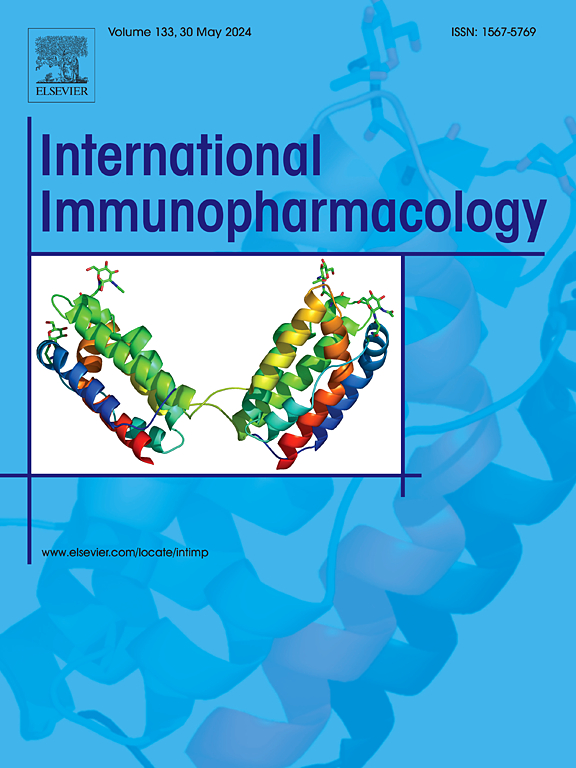丁香酸通过调节细胞信号通路减轻镉诱导的大鼠神经毒性
IF 4.7
2区 医学
Q2 IMMUNOLOGY
引用次数: 0
摘要
镉(Cd)是一种广泛存在于自然界的金属,它通过对体内各种活性氧的影响,影响细胞的DNA修复机制,对大脑健康产生负面影响。抗氧化剂提供了减少镉的神经毒性作用的潜力。因此,我们旨在研究丁香酸(SA)对镉致神经毒性的保护作用。研究中使用了50只雄性斯普拉格·道利大鼠。将大鼠分为对照组、SA100组、Cd组、SA50 + Cd组和SA100 + Cd组,Cd (6.5 mg/kg)腹腔注射,SA (50 ~ 100 mg/kg)腹腔注射,连续7 d。我们的研究结果表明,SA显著减轻cd诱导的脑损伤。SA可显著逆转Cd诱导的脑组织MDA上调和GSH、SOD、CAT下调。此外,Nrf2/HO-1/SIRT1的表达被Cd诱导的ROS破坏,而SA则增强了Nrf2/HO-1/SIRT1的表达。Cd通过TLR4/NF-κB触发IL-1β、TNF-α等促炎因子,抑制IL-10引起炎症,SA则减轻组织炎症。本研究表明,SA处理显著逆转Beclin-1和LC3A/B的表达。最后,我们发现SA通过降低Bax、Caspase3水平和增加Bcl2水平来抑制cd诱导的细胞凋亡。总的来说,我们的数据显示SA通过调节大鼠大脑中cd诱导的各种细胞信号通路来发挥其神经保护作用。本文章由计算机程序翻译,如有差异,请以英文原文为准。
Syringic acid alleviates cadmium-induced neurotoxicity in rats by modulating cellular signaling pathways
Cadmium (Cd) is a metal found widely in nature that negatively affects brain health by affecting the DNA repair mechanisms of the cell through the effect it creates on various reactive oxygen species in the body. Antioxidants provide the potential to reduce the neurotoxic effects of cadmium. Therefore, we aimed to investigate the protective properties of syringic acid (SA) in cadmium-induced neurotoxicity. Fifty male Sprague Dawley rats were used in the study. The rats were divided into 5 groups: Control, SA100, Cd, SA50 + Cd and SA100 + Cd. Cd (6.5 mg/kg) was administered intraperitoneally, and SA (50–100 mg/kg) intragastrically for seven days. Our results showed that SA significantly mitigated Cd-induced brain damage. The up-regulation of MDA and down-regulation of GSH, SOD, and CAT in brain tissues induced by Cd was significantly reversed by SA treatment. Additionally, the decreased expression of Nrf2/HO-1/SIRT1, impaired by ROS induced by Cd, was enhanced by SA. While Cd caused inflammation by triggering proinflammatory cytokines such as IL-1β and TNF-α via TLR4/NF-κB and suppressing IL-10, SA reduced inflammation in the tissue. This study demonstrated that SA treatment significantly reversed Beclin-1 and LC3A/B expression. Finally, it was revealed that SA treatment inhibited Cd-induced apoptosis by decreasing Bax, Caspase3 levels, and increasing Bcl2 levels. Collectively, our data revealed that SA exerts its neuroprotective effects by regulating various Cd-induced cellular signaling pathways in rat brains.
求助全文
通过发布文献求助,成功后即可免费获取论文全文。
去求助
来源期刊
CiteScore
8.40
自引率
3.60%
发文量
935
审稿时长
53 days
期刊介绍:
International Immunopharmacology is the primary vehicle for the publication of original research papers pertinent to the overlapping areas of immunology, pharmacology, cytokine biology, immunotherapy, immunopathology and immunotoxicology. Review articles that encompass these subjects are also welcome.
The subject material appropriate for submission includes:
• Clinical studies employing immunotherapy of any type including the use of: bacterial and chemical agents; thymic hormones, interferon, lymphokines, etc., in transplantation and diseases such as cancer, immunodeficiency, chronic infection and allergic, inflammatory or autoimmune disorders.
• Studies on the mechanisms of action of these agents for specific parameters of immune competence as well as the overall clinical state.
• Pre-clinical animal studies and in vitro studies on mechanisms of action with immunopotentiators, immunomodulators, immunoadjuvants and other pharmacological agents active on cells participating in immune or allergic responses.
• Pharmacological compounds, microbial products and toxicological agents that affect the lymphoid system, and their mechanisms of action.
• Agents that activate genes or modify transcription and translation within the immune response.
• Substances activated, generated, or released through immunologic or related pathways that are pharmacologically active.
• Production, function and regulation of cytokines and their receptors.
• Classical pharmacological studies on the effects of chemokines and bioactive factors released during immunological reactions.

 求助内容:
求助内容: 应助结果提醒方式:
应助结果提醒方式:


